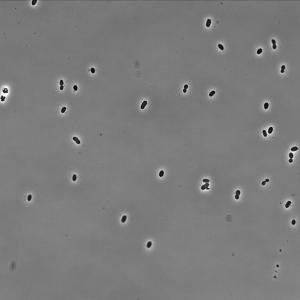Feb 3 2015
Indiana University biologists believe they have found a faster, cheaper and cleaner way to increase bioethanol production by using nitrogen gas, the most abundant gas in Earth's atmosphere, in place of more costly industrial fertilizers. The discovery could save the industry millions of dollars and make cellulosic ethanol - made from wood, grasses and inedible parts of plants - more competitive with corn ethanol and gasoline.
 Indiana University Bloomington biologists have discovered that the bioethanol-producing bacterium Zymomonas mobilis, when coupled with nitrogen gas, can produce fuel faster and more efficiently than current methods. Shown here is a whole field microscopy image of Z. mobilis, including some dividing cells. Credit: Breah LaSarre, Indiana University
Indiana University Bloomington biologists have discovered that the bioethanol-producing bacterium Zymomonas mobilis, when coupled with nitrogen gas, can produce fuel faster and more efficiently than current methods. Shown here is a whole field microscopy image of Z. mobilis, including some dividing cells. Credit: Breah LaSarre, Indiana University
The raw materials for cellulosic ethanol are low in nitrogen, a nutrient required for ethanol-producing microbes to grow, so cellulosic ethanol producers are estimated to spend millions of dollars annually on nitrogen fertilizers like corn steep liquor and diammonium phosphate. But an IU team led by biologist James B. McKinlay has found that the bioethanol-producing bacterium Zymomonas mobilis can use nitrogen gas (N2) as a nitrogen source, something that the more traditional ethanol-producer, baker's yeast, cannot do.
"When we discovered that Z. mobilis could use N2 we expected that it would make less ethanol. N2 utilization and ethanol production demand similar resources within the bacterial cell so we expected resources to be pulled away from ethanol production to allow the bacteria to grow with N2," McKinlay said. "To our surprise the ethanol yield was unchanged when the bacteria used N2. In fact, under certain conditions, the bacteria converted sugars to ethanol much faster when they were fed N2."
Knowing the bacterium could use N2 without hindering ethanol production, the team reasoned that N2 gas could serve as an inexpensive substitute for nitrogen fertilizers during cellulosic ethanol production.
"Until recently, ethanol has been produced almost entirely from food crops, but last year there was a surge in cellulosic ethanol production as several commercial facilities opened," McKinlay said. "Cellulosic ethanol offers more favorable land use and lower carbon emissions than conventional ethanol production. Even so, cellulosic ethanol is struggling to be cost-competitive against corn ethanol and gasoline."
The largest cost contributors to cellulosic ethanol production are the cellulosic plant material and the enzymes needed to degrade the plant material into sugars that are converted into ethanol, so they have received the most attention.
"But we recognized nitrogen fertilizers as a smaller, yet considerable, cost contributor that could potentially be more readily addressed," he said.
They estimated that using N2 gas, which can be produced on-site at production facilities, in place of costly nitrogen supplements could save an ethanol production facility over $1 million dollars a year. Using N¬2 gas could also have environmental benefits such as avoiding carbon dioxide emissions associated with producing and transporting the industrial fertilizers.
"More work needs to be done to assess how this approach can be integrated and optimized on an industrial scale, but all of the data we've collected thus far are very encouraging," McKinlay said.
A provisional patent has also been filed in relation to the study with the United State Patent and Trademark Office, he added.